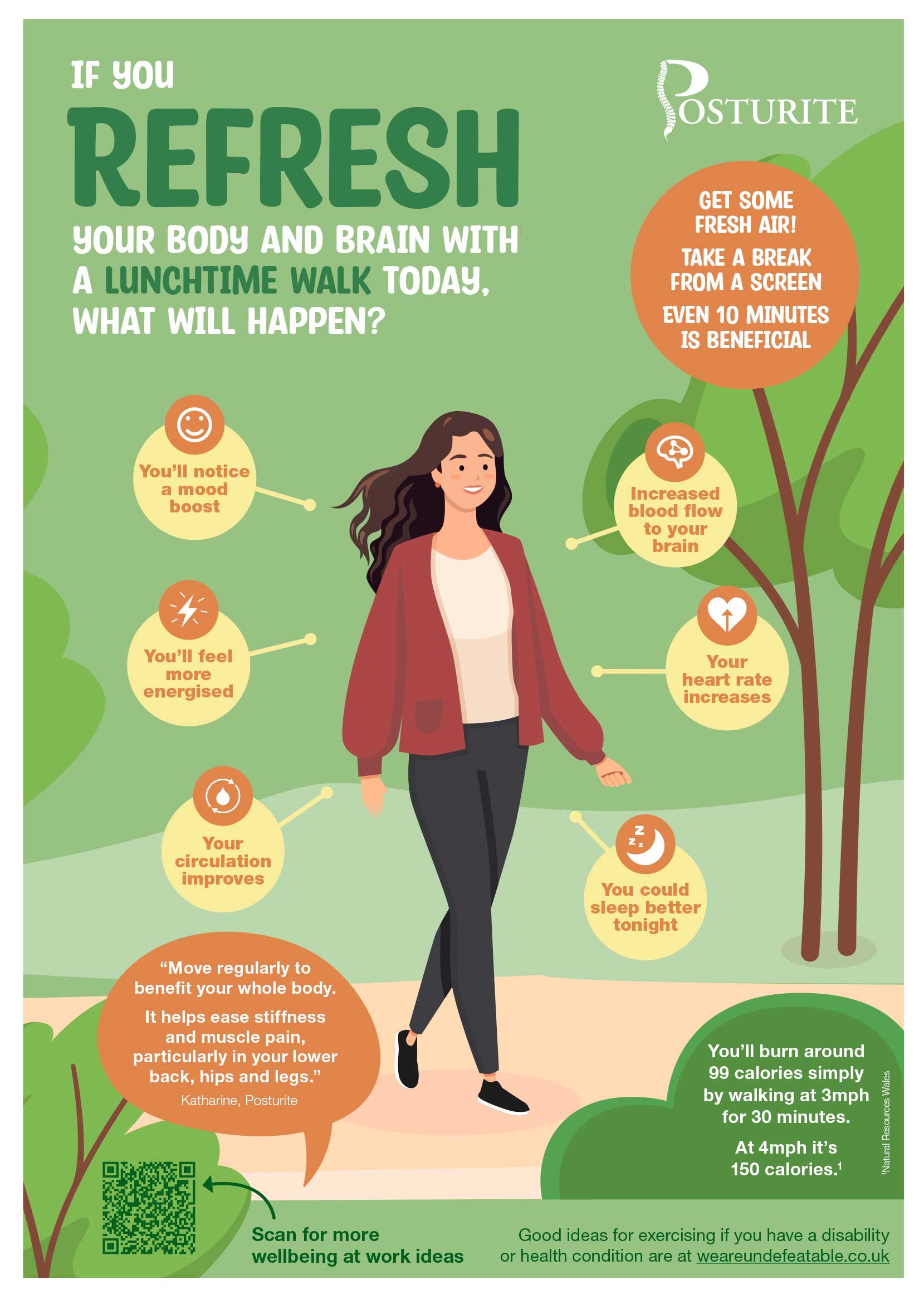If you refresh your body and brain with a lunchtime walk on a work day, what will happen?
- Your circulation improves
- You’ll feel more energised
- Your heart rate increases
- There’s increased blood flow to your brain
- You’ll notice a mood boost
- You could sleep better tonight
The wellbeing at work team at Posturite has created a poster to promote all these brilliant health benefits of taking a walking break during the working day. Remember, even a short walk is beneficial physically and mentally!
Find your free workplace wellbeing poster below, click here to download a PDF version of the walking infographic, and read on to explore the health benefits of walking in more detail.
The mental wellbeing benefits of walking breaks at work
I asked a business psychologist, Ellice Whyte from Mindset, if she feels the mental wellbeing benefits of walking breaks at work are as important as the physical?
“We often talk about the benefits of exercise for our bodies but don’t necessarily consider the benefits to our brains. Research shows walking in particular improves brain function, helping us feel more alert, improving our mood, creativity and decision-making.”
And does she practice what she preaches?
“I walk the dog nearly every lunch break for at least 30 minutes, and for me it feels like a chance to reset and recharge! The lunchtime walk helps me to work productively and maintain my energy levels consistently throughout a work day.”
Walking in nature improves your mood, helping you feel positive and less stressed, found researchers at the University of Edinburgh in their report ‘Effectiveness of nature-based walking interventions in improving mental health in adults’.
Even if you’re not lucky enough to have a park or green space near to your workspace, the digital break of going for a walk and getting away from screens and demands will feel good.
The physical wellbeing benefits of walking breaks at work
Scientists from the University of Cambridge, including Dr Leandro Garcia, concluded in 2022 that just 11 minutes a day of moderate physical activity, such as brisk walking, lowers the risk of an early death. They analysed 196 peer-reviewed studies, covering 30 million people, and found the moderate physical activity reduced the risk of developing heart and circulatory diseases and cancer.
The charity Living Streets recommends:
“Just taking a 20-minute walk on your lunch break can have fantastic health benefits, helping to stave off chronic conditions like heart disease, certain cancers and diabetes.”
You could even take CPD accredited training from Living Streets to become a ‘Workplace Walk Champion’ in your organisation.
Katharine Metters, Lead Consultant in Ergonomics at Posturite, also encourages the boost of physical activity in a daily routine.
“Move regularly to benefit your whole body. It helps ease stiffness and muscle pain, particularly in your lower back, hips and legs. Walking breaks at work really are powerful.”
What pace of walking brings the health benefits?

All walking speeds are good for your health.
If brisk walking is comfortable for you, then you can increase the calorie burn at this faster pace. For example, you’ll burn around 99 calories by walking at 3 miles per hour for 30 minutes, and at 4 miles per hour, it would be 150 calories.
By the way, the NHS defines ‘brisk walking’ as still being able to talk while walking, but not being able to sing!
The best way to spend a weekday lunch break?
Think to yourself, could a weekday lunch break be better spent:
- Walking outdoors, looking around at the real world and moving your body?
Instead of:
- Inactive, hunched over a phone in a windowless room, looking at the virtual world?
When is National Walking Day in 2025 in the UK?
National Walking Day is Wednesday 2 April 2025. Display the free walking poster in your workplace, to encourage as many colleagues as possible to take part in National Walking Day.
When is National Walking Month in 2025 in the UK?
National Walking Month is May 2025, and is a fantastic opportunity to promote the health benefits of walking to all.
How can I keep active if I’m not able to walk?
Good ideas for exercising if you have a disability or health condition are on the We Are Undefeatable website.
One option the NHS advises is swimming if your joints are a problem. You could take part in an Aquafit class because the water helps to support your joints while you move, and can help you strengthen your muscles.
Seated exercises are also very good for you – explore whether the Workstation Exercises in this Posturite advice sheet could be achievable for you.
Walk on, with hope in your heart
I hope you’ll down tools and head out for a walk after reading this blog. Your heart, your brain, your back and every aspect of your physical and mental health will thank you for the effort.
Read next:
- Active working myths, legends and truths: an infographic
- An office worker's guide to 10,000 steps a day
- Infographic explores benefits of taking microbreaks
Watch next: Move more at work: treat your body and brain













